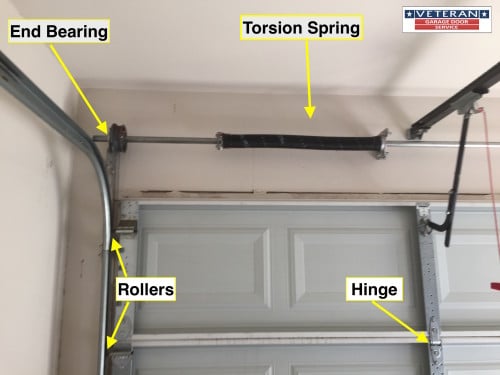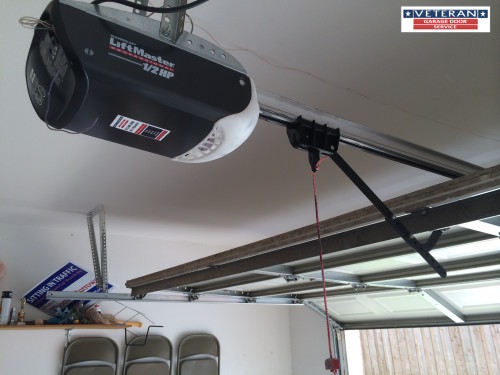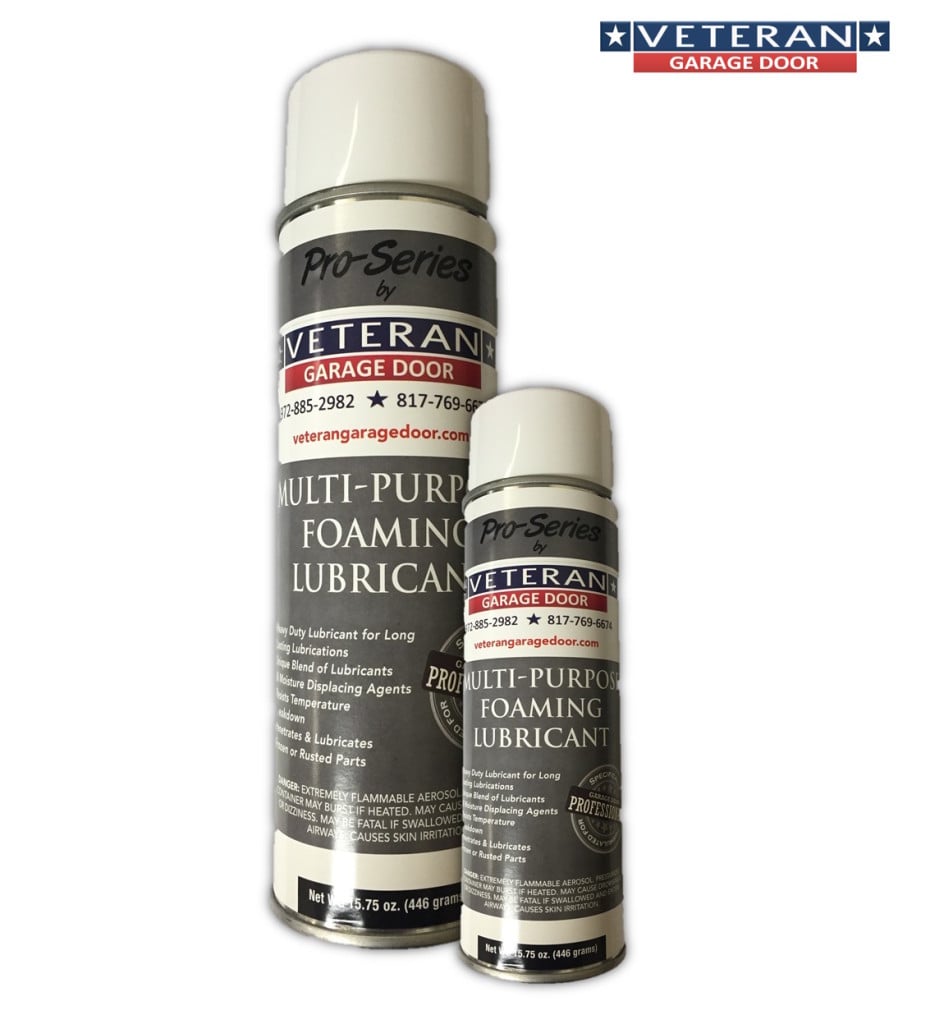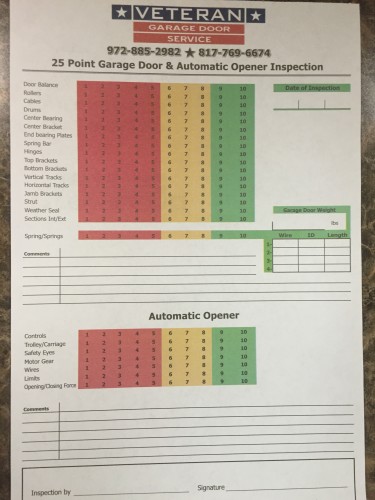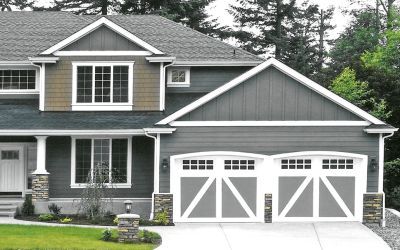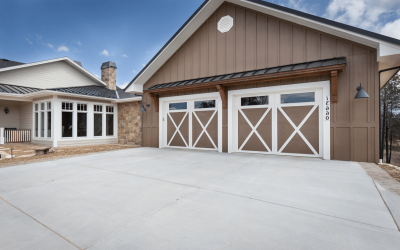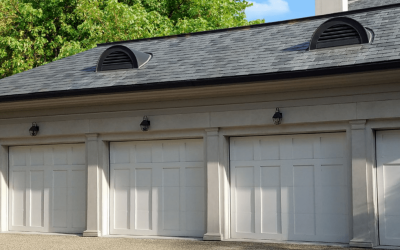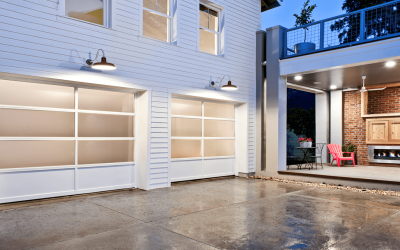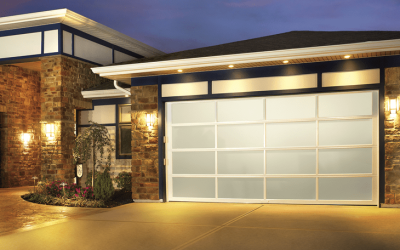Veteran Garage Door provides a lube and tune service and 25 point inspection form that is designed to
provide a full evaluation of the garage door system. The lube and tune provides the maintenance that
each component needs to keep it functioning properly.
The lube portion includes lubricating the hinges, rollers, bearing plates, center bearing and the spring(s)
on the garage door. We use high quality garage door spray lubricant and instruct the home owner how
to periodically lubricate these moving parts on the garage door.
The tune up portion involves lubricating the moving parts on the garage door opener and checking the
travel limits and travel force settings. We use white silicone grease to lubricate the garage door opener.
The parts on the opener to be lubricated vary depending on the style of opener. On screw drive openers
the screw itself is lubricated along with the trolley. On chain drive openers, the sprocket on top of the
unit is lubricated along with the trolley and operator rail the trolley travels on. We also check the chain
for proper tension and adjust as necessary. On belt drive openers the top sprocket is lubricated along
with the operator rail and trolley. Proper lubrication will help keep your garage door opener functioning
properly for many years of service.
* We recommend lubricating the door at minimum twice per year and the opener once per year
Our garage door inspection form provides a piece by piece inspection of the garage door system and the
garage door opener. The inspection form is completed by the technician with the homeowner present
and the homeowner is asked to sign off on the form once it is complete. This form then remains with the
garage door and a copy is kept on file at our office for future use. The inspection form provides
information to the condition of the parts at the time of the inspection. Our rating system per item is
Good, OK, and Poor.
Items Inspected
1. Door balance: if the door is balanced we know the spring is functioning properly.
2. Rollers: we inspect each individual roller for signs of wear or breakage.
3. Cables: we inspect the cables for fraying and kinking which lead to breakage.
4. Drums: we inspect the drums for cracking and unusual wear.
5. Center Bearing: inspected for wear and or burned out bearings. There are two types of center
bearings, a single piece nylon bearing and a metal housing with actual ball bearings.
6. Center Bracket: inspected for bending and other damage.
7. End Bearing Plates: these bearing plates are at each end of the spring bar mounted outside the
drums. The bearings allow the spring bar to turn freely as the door opens and closes.
8. Spring Bar: inspected for rust and bending. The spring bar holds the springs and the spring bar
turns as the door opens and closes.
9. Hinges: inspected for damage and wear.
10. Top Brackets: these are the brackets that hold the top roller in place, inspected for wear and
breakage.
11. Bottom Brackets: These are the brackets mounted at the bottom of the bottom garage door
section. These brackets hold the bottom rollers in place and are also the location where the
cables attach to the bottom of the garage door. Inspected for wear, damage and breakage.
These brackets provide the lifting point on the garage door.
12. Vertical Tracks: inspected for bending and damage.
13. Horizontal Track: inspected for bending and damage.
14. Jamb Brackets: these brackets attach the vertical tracks to the frame work on the sides of the
garage door opening. Inspected for position, bending and other damage.
15. Strut: these are added supports for the garage door structure. Most doors have a strut mounted
at the top of the top garage door section. Some doors will have multiple struts depending on the
weight of the door and previous damage requiring additional struts for support.
16. Weather Seal: this is the rubber seal at the bottom of the garage door. Inspected for dry rot and
any other damage. This seal helps prevent wind and windblown objects from entering the
garage.
17. Section (interior/exterior): inspected for any dents, tearing in the metal and other damage.
18. Opener Controls: inspected to make sure the controls are functioning properly.
19. Opener Trolley/Carriage: inspected for damage and grinding in screw drive openers.
20. Safety Eyes: inspected for proper function. The safety eyes keep the door from closing if a
person or object is in the garage doors path.
21. Motor Gear: inspected for wear. In belt and chain drive we check the belt/chain for proper
tension.
22. Wires: visual inspection for any signs of breakage or cracking in the wire coating.
23. Limits: test the limits to ensure the door opens and closes to the proper travel locations.
24. Opening/Closing Force: test the force limits to ensure there is not too much or too little force
being applied to the door during opening and closing.
25. Springs: we visually inspect the springs for signs of rust and wear. We also measure each spring
to determine the weight of the garage door, based on the spring(s) installed on the door.
The inspection form is our written evaluation of your garage door system. We make repair
recommendations based on this evaluation form. We rate each listed item as Good, OK or Poor. It is
always the homeowners decision as to what items need attention and this form acts as a guide for the
decision making process. Veteran Garage Door technicians can assist the homeowner in identifying the
most critical repairs and maintenance items and then provide quality parts and repairs.
Rate this page




